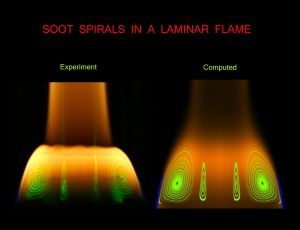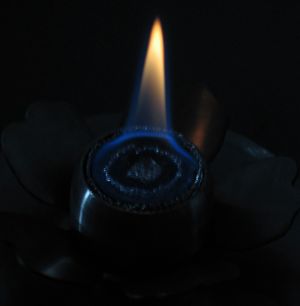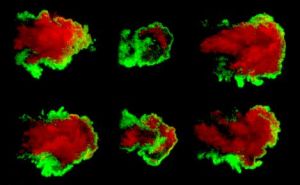
“In a nonpremixed jet flame formation of soot takes place within the flame zone. While soot particles are transported away from the flame zone they experience Newtonian, thermophoretic, and pressure forces induced via particle-fluid interaction. These forces in a centerbody flame produce a spectacular spiraling motion for the soot particles. Traces of soot particles (green) are visualized in the experiment by shining a YAG laser sheet. Radiation from soot (orange) and emission from excited CH radicals (blue) are also captured in the direct photograph of the laboratory flame. Calculations for this flame are performed using UNICORN code. Trajectories of the soot particles are shown in green, soot radiation is shown in orange and CH concentration is shown in blue. Soot particles originating at the flame surface are moving toward the center of the primary recirculation zone in a helical pattern. Some soot particles are also entering the secondary recirculation zone.”
Scott Stouffer, Viswanath Katta, William Roquemore, Garth Justinger, Vincent Belovich, Amy Lynch, Joe Miller, Robert Pawlik, Joseph Zelina, Sukesh Roy, Keith Grinstead and James Gord (Air Force Research Laboratory, Propulsion Directorate, Wright Patterson Air Force Base)

“A dual cylinder wick lamp creates a flame inside an outer flame. The flame of the picture uses 91% rubbing isopropyl alcohol has a burning, vacuum column surrounded by a pink layer and a blue layer cylinder flame. The vacuum column holds the flame perimeter toward the center. The warm air flow through a heated almond flower surrounds the flame to improve the combustion of the outer flame and protect the outer flame from the wind. When the wind gets strong, the adequately warmed air, passing through the air channels in the center and between the cylinder wicks, increases. It increases the strength of the flame and results smokeless from the flame under windy conditions. The stronger the wind blows, the tougher the flame stands. This Almond Flame shows clean laminar flow offers steady purification, and strength under windy conditions offers unlimited fortune.”
Susumu Matsuyama (Almond Lamp Corporation)

“This is an image of a spherical diffusion flame of ethylene burning in air in the NASA GRC 2.2 s drop tower. The image was recorded about 1.4 s after ignition. The ethylene flowrate is 1.5 mg/s and the scale is revealed by the 6.5 mm porous sphere visible in the image. The image was recorded using a Nikon D100 digital single-lens reflex camera with a 125 ms exposure.”
P.B. Sunderland (University of Maryland), D.L. Urban and D.P. Stocker (NASA Glenn Research Center), B.H. Chao (University of Hawaii) and R.L. Axelbaum (Washington University)

“CH* chemiluminescence imaging of cylindrical detonations in an C2H2 + O2 mixture. Successive detonations were initiated at the center points in a manner described in Cetegen, B. M., Crary, F. L. and Dabora, E. K., ‘The interaction of periodically generated cylindrical detonations in a simulated hypersonic flow,’ Proceedings of the Combustion Institute, Vol. 28, pp. 629-635, 2000.”
Baki Cetegen, Lynwood Crary and Eli Dabora (University of Connecticut)

“The picture shows simultaneous planar images of the soot (red) and OH-radical (green) distributions in combusting diesel fuel jets at various stages of development. They were acquired in an optically accessible diesel engine using overlapping laser sheets for planar laser-induced incandescence (PLII) of the soot and planar laser-induced fluorescence (PLIF) of the OH. The two simultaneous images were acquired using two intensified CCD cameras, false-colored to show the soot in red and OH in green, and then superimposed to form a single image. These images were acquired as part of an ongoing study of in-cylinder processes in diesel engines to reduce emissions and improve the efficiency of these engines.”
John Dec (Sandia National Laboratories) and Dale Tree (Brigham Young University)